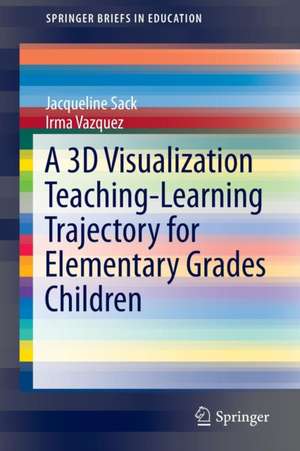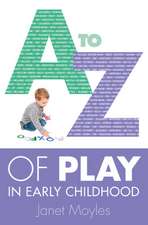A 3D Visualization Teaching-Learning Trajectory for Elementary Grades Children: SpringerBriefs in Education
Autor Jacqueline Sack, Irma Vazquezen Limba Engleză Paperback – 30 mar 2016
Din seria SpringerBriefs in Education
-
 Preț: 317.28 lei
Preț: 317.28 lei -
 Preț: 478.71 lei
Preț: 478.71 lei - 20%
 Preț: 387.43 lei
Preț: 387.43 lei - 17%
 Preț: 392.10 lei
Preț: 392.10 lei -
 Preț: 196.30 lei
Preț: 196.30 lei -
 Preț: 394.40 lei
Preț: 394.40 lei -
 Preț: 356.31 lei
Preț: 356.31 lei -
 Preț: 444.52 lei
Preț: 444.52 lei -
 Preț: 196.15 lei
Preț: 196.15 lei -
 Preț: 262.86 lei
Preț: 262.86 lei -
 Preț: 370.60 lei
Preț: 370.60 lei -
 Preț: 376.59 lei
Preț: 376.59 lei -
 Preț: 379.68 lei
Preț: 379.68 lei -
 Preț: 408.44 lei
Preț: 408.44 lei -
 Preț: 376.22 lei
Preț: 376.22 lei -
 Preț: 378.34 lei
Preț: 378.34 lei -
 Preț: 346.59 lei
Preț: 346.59 lei -
 Preț: 377.18 lei
Preț: 377.18 lei -
 Preț: 377.35 lei
Preț: 377.35 lei -
 Preț: 476.03 lei
Preț: 476.03 lei -
 Preț: 376.43 lei
Preț: 376.43 lei -
 Preț: 379.48 lei
Preț: 379.48 lei -
 Preț: 479.29 lei
Preț: 479.29 lei -
 Preț: 340.61 lei
Preț: 340.61 lei -
 Preț: 377.18 lei
Preț: 377.18 lei -
 Preț: 377.57 lei
Preț: 377.57 lei -
 Preț: 376.59 lei
Preț: 376.59 lei -
 Preț: 377.18 lei
Preț: 377.18 lei -
 Preț: 380.84 lei
Preț: 380.84 lei -
 Preț: 379.09 lei
Preț: 379.09 lei -
 Preț: 354.09 lei
Preț: 354.09 lei -
 Preț: 377.95 lei
Preț: 377.95 lei -
 Preț: 379.68 lei
Preț: 379.68 lei -
 Preț: 377.35 lei
Preț: 377.35 lei -
 Preț: 346.59 lei
Preț: 346.59 lei -
 Preț: 444.52 lei
Preț: 444.52 lei -
 Preț: 376.22 lei
Preț: 376.22 lei -
 Preț: 381.21 lei
Preț: 381.21 lei -
 Preț: 348.13 lei
Preț: 348.13 lei -
 Preț: 409.25 lei
Preț: 409.25 lei -
 Preț: 410.17 lei
Preț: 410.17 lei -
 Preț: 377.57 lei
Preț: 377.57 lei -
 Preț: 380.63 lei
Preț: 380.63 lei -
 Preț: 376.59 lei
Preț: 376.59 lei -
 Preț: 377.57 lei
Preț: 377.57 lei -
 Preț: 380.07 lei
Preț: 380.07 lei -
 Preț: 378.54 lei
Preț: 378.54 lei -
 Preț: 379.48 lei
Preț: 379.48 lei -
 Preț: 377.73 lei
Preț: 377.73 lei -
 Preț: 342.74 lei
Preț: 342.74 lei
Preț: 374.08 lei
Nou
Puncte Express: 561
Preț estimativ în valută:
71.58€ • 74.94$ • 59.23£
71.58€ • 74.94$ • 59.23£
Carte tipărită la comandă
Livrare economică 05-19 aprilie
Preluare comenzi: 021 569.72.76
Specificații
ISBN-13: 9783319297989
ISBN-10: 3319297988
Pagini: 44
Ilustrații: VI, 44 p. 31 illus.
Dimensiuni: 155 x 235 x 3 mm
Greutate: 0.09 kg
Ediția:1st ed. 2016
Editura: Springer International Publishing
Colecția Springer
Seria SpringerBriefs in Education
Locul publicării:Cham, Switzerland
ISBN-10: 3319297988
Pagini: 44
Ilustrații: VI, 44 p. 31 illus.
Dimensiuni: 155 x 235 x 3 mm
Greutate: 0.09 kg
Ediția:1st ed. 2016
Editura: Springer International Publishing
Colecția Springer
Seria SpringerBriefs in Education
Locul publicării:Cham, Switzerland
Cuprins
1. Introduction/ Preface.- 1.1 Project's origins.- 1.2 Brief overview of the book’s organization.- 2. Theoretical Frameworks.- 2.1 Why are visualization skills important?.- 2.2 Research methodology.- 2.3 Spatial Operational Capacity framework.- 2.4 School and classroom context.- 2.5 Pre-program interview.- 3. Introductory Activities.- 3.1 Four block houses.- 3.2 The Soma puzzle figures.- 3.3 Coordinating 2-Soma assembly figures.- 4. 2D to 3D to abstract top-view plans – Geocadabra interface.- 4.1 Learning to use Geocadabra – the Geobuddy manual.- 4.2 Explaining Difficult Figures in the Geocadabra manual.- 4.3 Front side top views.- 5. 3D to 2D via top-view numeric plans.- 5.1 Self-created task card puzzles; solving others’ puzzle cards.- 5.2 Finding multiple solutions for each puzzle card.- 5.3 Invention of a coding system for assembly figures with holes or overhangs.- 5.4 Extended Construction Box – making sense of 3-space using shadows.- 5.5 Rectangular prisms and top-viewnumeric representations - making sense of the LWH volume formula.- 6. Connections to numeracy.- 6.1 Expanding and scaling the Soma cube.- 6.2 Permutations within cake patterns.
Caracteristici
Uses a design research methodology that has evolved over 8 years Meets the need for children to develop visualization skills through hands-on experiences Includes connections to the numeracy strands in the elementary curriculum Emphasizes children's self-created problems Includes supplementary material: sn.pub/extras














